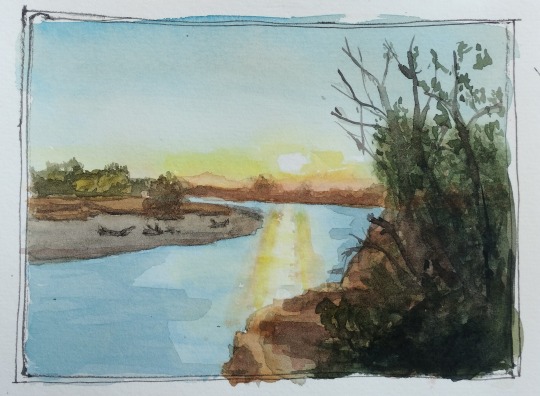#Tanque Verde Wash
Text
Dried Weed
Dried Weed — Photo-Artistry by kenne
Timeless Moments
There’s a trail down by the washWhere once new life grew Providing a new beginningThat has turned into an end.All manner of thingsShall be well, providing aPattern of timeless moments.
— kenne
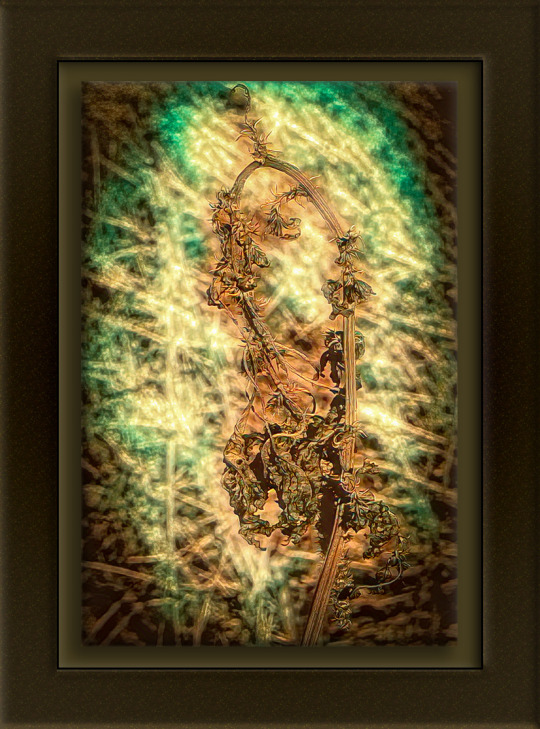
View On WordPress
2 notes
·
View notes
Photo

Fremont Cottonwoods (Populus fremontii) along the Tanque Verde Wash, Pima County, Arizona.
136 notes
·
View notes
Photo

Lizard in the wash at Tanque Verde Loop Road
fairly large (not the usual size running around Tucson); don’t know my herps, though.
any idea what it is?
11 notes
·
View notes
Text
March Madness - Tucson, AZ

The above picture was taken from one of the cafeterias at University Hospital in Tucson, where I had breakfast while Doug was in surgery. I think the surgery lasted a couple of hours, the surgeon talked to me after the surgery - all went well and the atrial fibrillation should stop. After a one-night stay, Doug was sent on his way. We were grateful to have the surgery over with and to be on the road to recovery. Activities were limited for a week, then Doug was free to resume normal activities. Onward we go!

A week after his surgery, Doug was back on the golf course, awesome!
HOWE TIME FLIES
About 10 days after Doug’s surgery, our friends Art and Donna Howe came to visit us. It was their first time in Tucson, so we planned a whirlwind tour to give them a little taste of desert living.
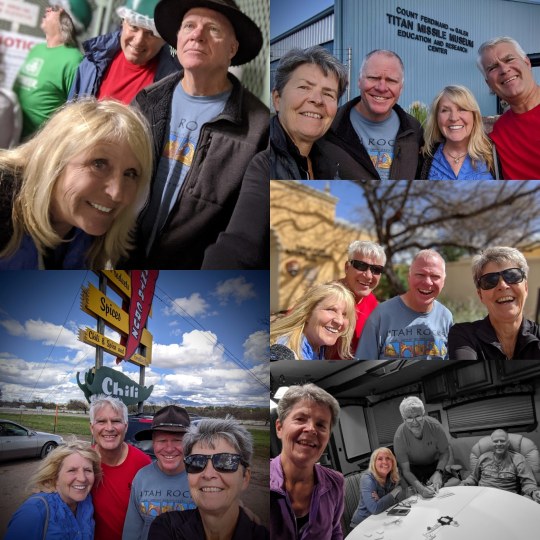
On their first day in town, we headed south to the Titan Missile Museum, we managed to arrive in time to sign up for a tour (they fill up fast!) We have been on the tour three times now, we still love it. I would recommend a visit when you are in the area, it is just off I-19, about a 30 minute drive from downtown Tucson. After the museum, we drove further south to Tubac. We wandered around town, taking in a few of the artisan shops and some of the local artwork:

One of multiple painted javelinas in the village of Tubac.

Donna made a new friend in Tubac.
After a lunch stop at one of the local restaurants, we meandered back through the village for a little more exploring. Getting our fill of Tubac, we continued southward to the Santa Cruz Spice Company. We did a little spice shopping and then made our final stop of the day at the Tumacacori National Historic Park. It was a gorgeous spring day, which made for some fantastic photo ops at the mission.

Look at those spring flowers and the magnificent sky!
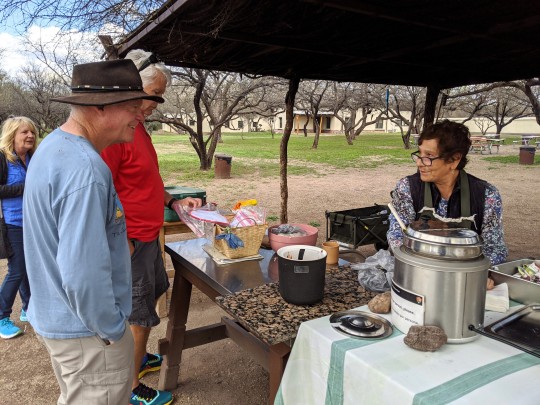
We stopped at the tortilla and beans stand inside the park - yummy!

Crystal-clear day, the Santa Rita Mountains in the distance.

The craftsmanship on the buildings is amazing.
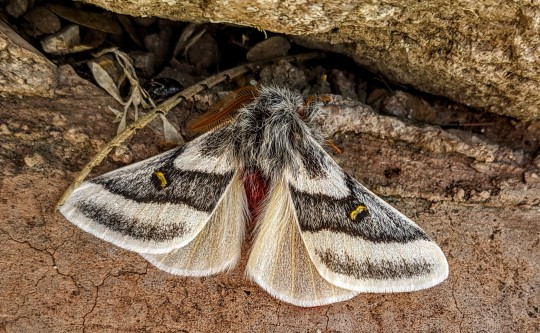
This moth was on one of the sidewalks at the mission, such pretty markings!
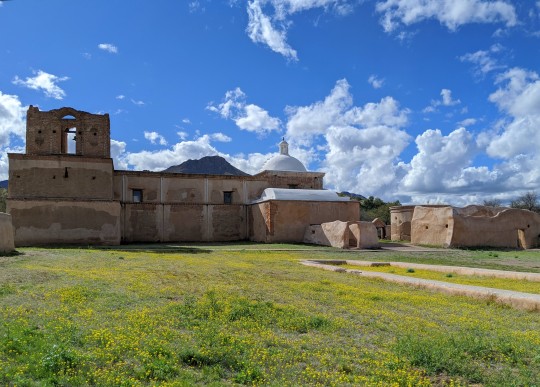
What a fun-filled day! We headed back to our trailer for dinner and games. More adventures planned for tomorrow!
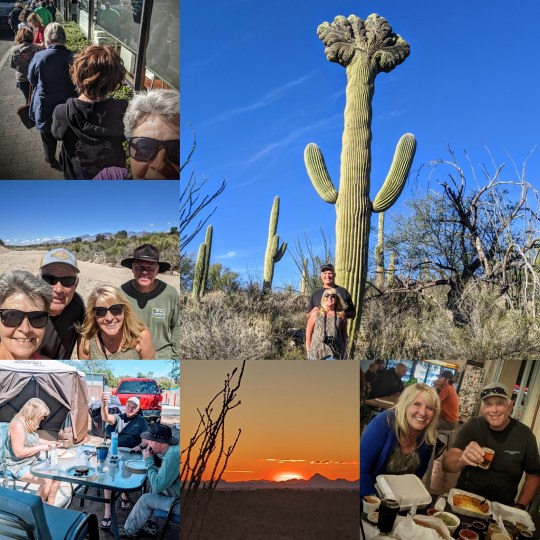
We filled the morning of the second day with a trip to Barrio Bread, a short walk along Pantano Wash, and then lunch on our patio. We went out to Saguaro National Park East to show them a crested saguaro on the Loma Verde Trail and for a sunset from Javelina Rocks. We ended the day with a trip to El Molinito for take-out and then went to the Arizona Beer House to enjoy our food and a few brews.
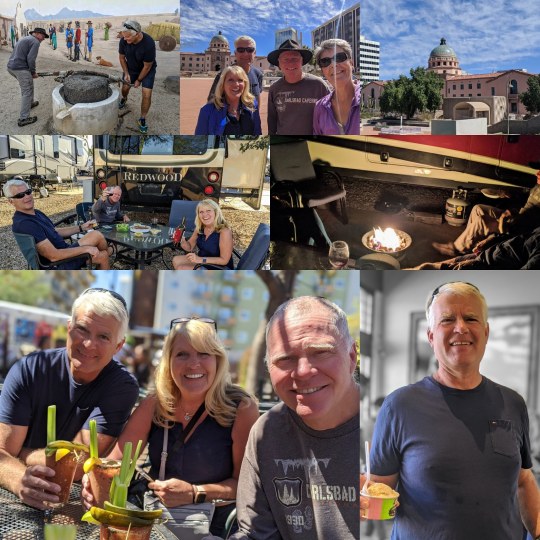
Day 3 - we headed to downtown Tucson. We walked along the Turquoise Trail, checking out the history of the area. We enjoyed adult beverages at The Congress Hotel Bloody Mary Bar and even found some ice cream for Art! We ended the day at the trailer, perfect weather for outdoor entertaining!
Day 4 - after a breakfast of sausage gravy & biscuits (vegan-style), we went to the range to whack a few golf balls around. We love the driving range at Fred Enke - the view of the Catalina Mountains is wonderful!
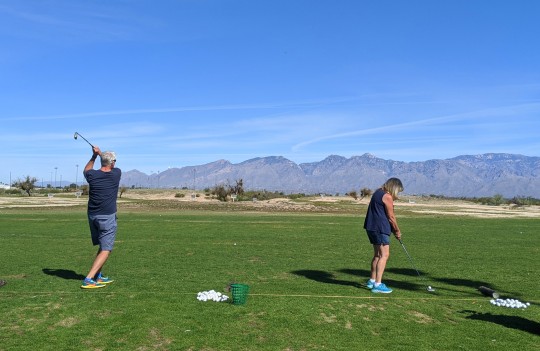
After golf, we made our way out to the Desert Museum. At this point, we were experiencing a mild shut-down and a few restrictions due to Covid-related concerns. A few of the exhibits at the Museum were closed and they were not doing the Raptor shows. However, we ran into a family on our way into the museum and they gave us 4 free passes. We had a great time wandering around the museum, it is always beautiful out there.

Brittle brush was blooming and the views to the west were spectacular!
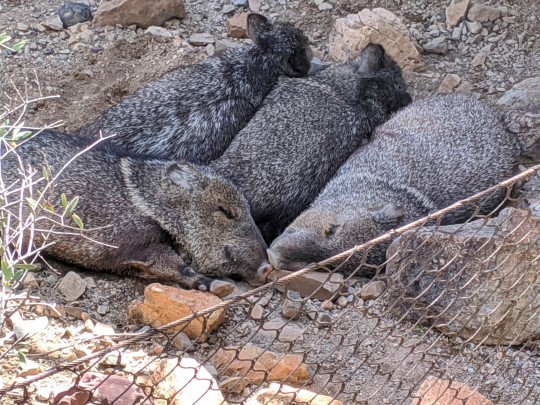
Caught the javelinas during naptime.
March is usually a great time to visit the museum, the temperatures aren’t too hot and the cactus are starting to bloom. We were not disappointed:
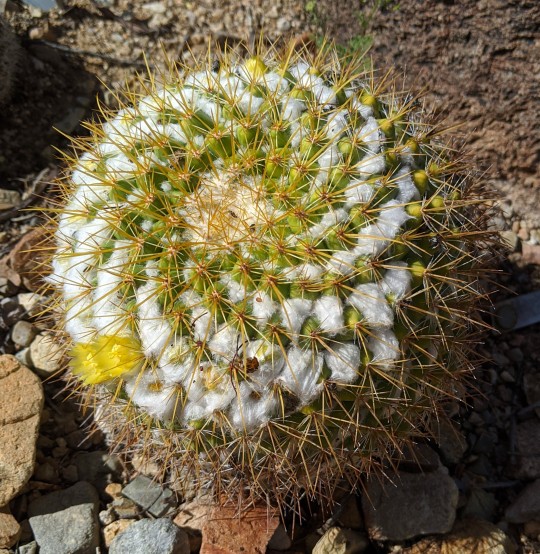

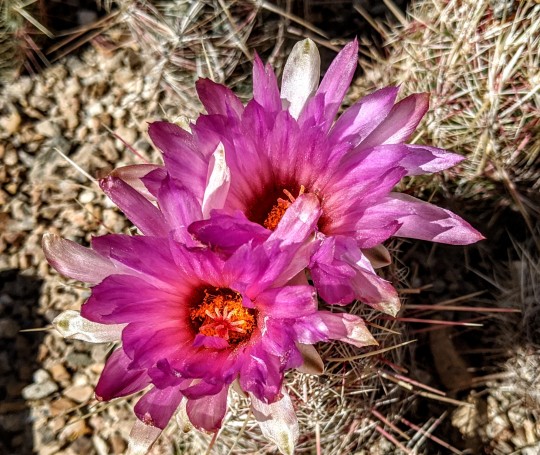
We completed our exploration of the Desert Museum and made the long drive back to our place. Happy hour, dinner, and then more games wrapped up our final night with the Howes. We are so happy that they finally came for a visit, we hope they will make it an annual thing!
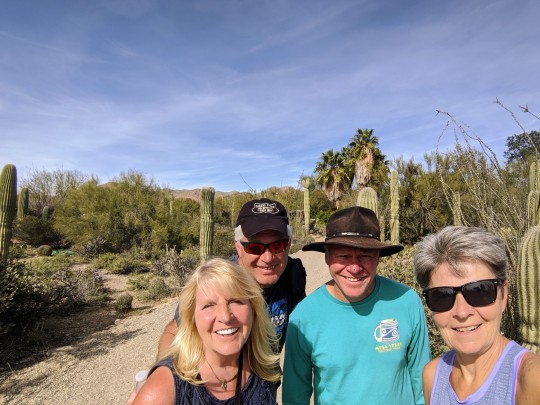
Thanks for coming to see us!
COVID INTERRUPTUS
The week following our friends visit things became more serious around the Covid virus. Restaurants and indoor spaces were closed down and we were forced to limit our activities with friends here in the park. Luckily, outdoor activities were a good option for us - we took lots of walks and bike rides. The weather was gorgeous and the flowers were blooming.
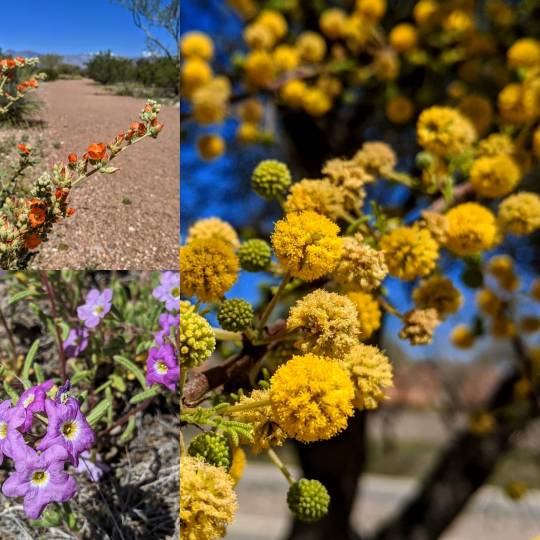
Pretty blooms along Pantano Wash during one of my many walks.

More desert colors!
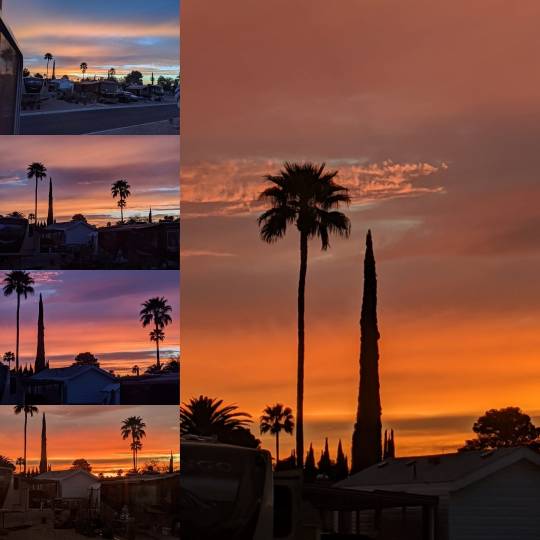
Some evenings the sky just explodes around here, we feel pretty lucky to be in a place where we can be outside enjoying nature most of the time.
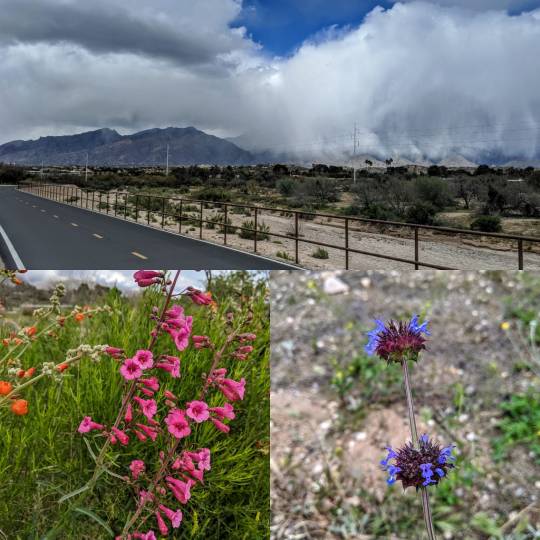
Photos from our 15 mile walk along Pantano Wash - the weather was cool, but we didn’t get wet, just a little wind-blown!
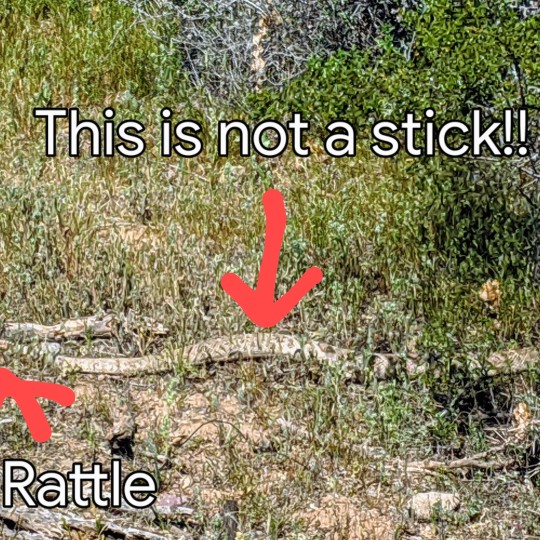
A nice rattler I came across on a bike ride up Harrison Greenway - yikes!

I was very grateful for my new e-bike, lots of great rides along the bike path here in town. Kept me from going stir crazy!
TANQUE VERDE RIDGE HIKE

During March Doug started training for his planned 2022 trip on the Continental Divide Trail (CDT). The CDT runs 3100 miles from the border of Mexico to the border of Canada, staying within 50 miles of the Continental Divide along its course. He is doing 3 consecutive days a week of 15+ miles each day with his backpack, just to see how his body holds up. Friday and Saturday he does his miles along the Pantano River Park path, then on Sundays he does an actual hike. I am joining him for 2 of those 3 days, my feet need a day off! Today we hiked around 16 miles on the Tanque Verde Ridge Trail. The hike is fairly steep and I think it is an understatement that my toes were REALLY happy to be done with the descent. Pretty sure I am going to need a few recovery days after this hike! In spite of the physical discomfort, it was a beautiful day in the desert and things were blooming along the ridge and Doug grilled us Beyond Meat burgers for dinner. Perfect end to the day!
REALITY HITS
By the end of March, we had come to the conclusion that our trip to Europe for this summer was going to have to be canceled. We had reservations to fly to England on May 9th and had planned to be over there until some time in August. Our plan had been to stay at AirBnBs, we were very disappointed to have to cancel all our plans, but Europe was closed down due to the spread of the Covid virus and things here in the United States were not looking any better. A large portion of our Canadian friends here in the RV park had already headed north, due to recommendations from their government. Social gatherings were frowned upon and we were doing our best to follow all of the social distancing guidelines in place. We decided that our best option is to stay in Tucson for the time being, as many RV parks and campgrounds are closed in the U.S. at this point due to Covid. We feel fortunate to have a place where we can wait this out. Guess we will just have to hang around for a few more Tucson sunsets.
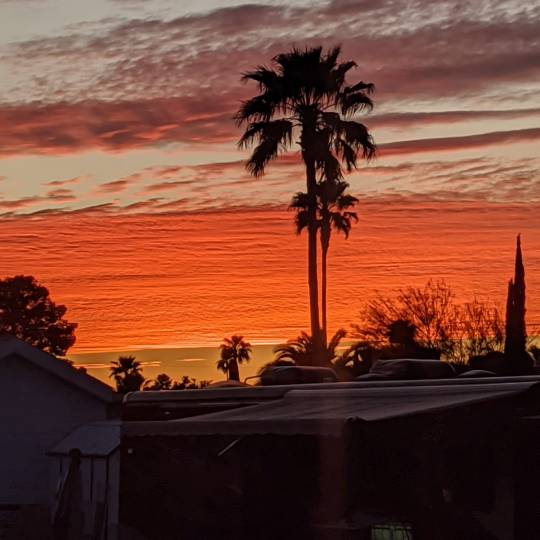
2 notes
·
View notes
Text
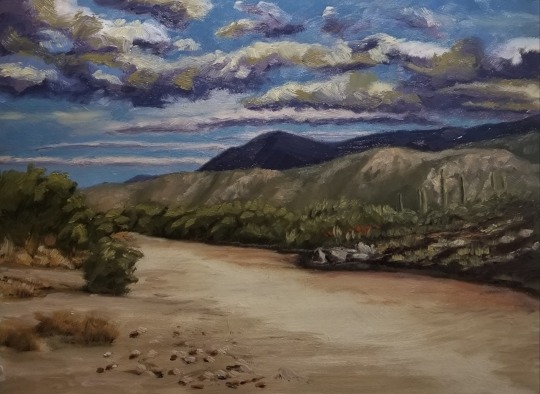
"Tanque Verde Wash" oil on 12x16" panel
#madeindc#oilpainting#dcartist#dcart#washingtondcartist#impressionist#contemporaryimpressionism#expressiverealism#arizonaart#desert#aridlands#westernart#landscape#nature#wildlands#Clouds
1 note
·
View note
Text
Riding Too Little

I have to keep it in perspective. If I was in Ohio, during a winter and got in 100+ miles a week....well, I would not be in Ohio during a winter, ha, ha. I signed up for the Willcox Flyer bike event and am ill prepared, unfit, etc... but I really need to get in a good ride. So, I've been riding and admiring the effects of our glorious monsoon.
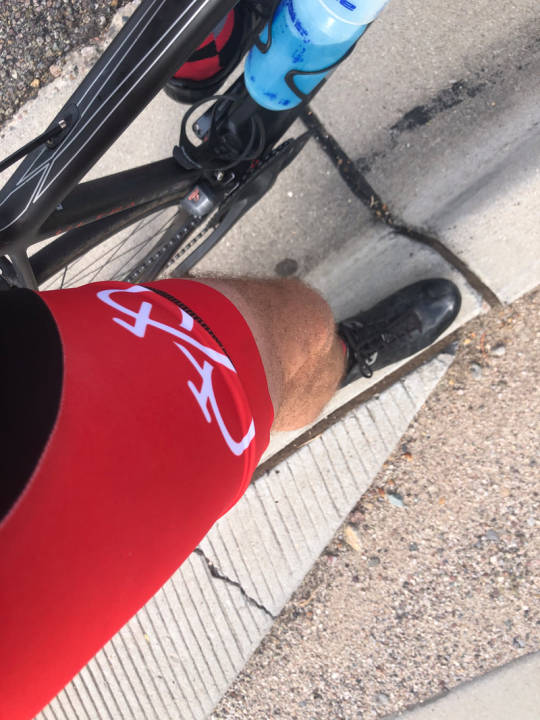
I ordered two new cycling shorts and went bold on one, black/red. I'm kind of a low key dresser so not sure how frequently I'll be wearing these.

Riding from the east side one day, I visited the Tanque Verde wash and it had a.....
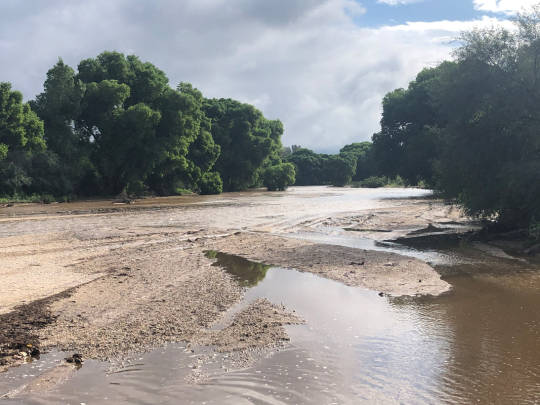
.....healthy flow. A couple of sheriff SUV's were there and they had just rescued someone who decided to try to drive through. Lot of that going on. The 3rd wettest monsoon on record has invigorated.....
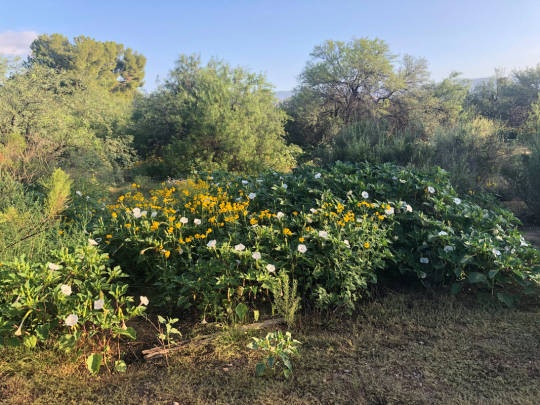
....jungle-like growth. OK, also initiated outbreaks of flies, mosquitoes, caterpillars, butterflies, Colorado River Frogs, etc... but it's worth it. I have often said that a summer here is far more livable than a winter in the midwest and that is so true and thinking back on the last 90 days, despite all the rain, probably only 3 days have kept me indoors. The good news is, it's now September and we are on the cusp of glorious weather.
Riding Too Little published first on https://throttlebuffsite.tumblr.com/
0 notes
Photo

The Tanque Verde Creek (left) merging with the Pantano wash to form The Rillito River. 🛸 DJI Mavic 2 Pro 📷 28.0 mm f/2.8 📋 10mm | 1/320s | f/6.3 | ISO-100 (PANO) 📅 August 2021 🚲 The Loop, Tucson, AZ https://bgboydphoto.com/drone © 2021 BG Boyd Photography
0 notes
Link
Construction Clean Up Post Construction Remodeling Junk Clean-Up Best Construction Site Cleaning Services and Cost In Tucson Arizona | Tucson Hauling Junk & Moving
More information is at: https://tucsonhaulingjunkmoving.com/construction-clean-up-near-me/
Are you looking for the Construction Clean Up Services near Tucson ARIZONA? Tucson Hauling Junk & Moving, is available to help clear out you Construction Clean Up Service. Our junk removal services provide a fast and easy solution for all your hauling needs. Cost? Free estimates! Send us a message or call us today. Best Construction Clean Up Services around Tucson ARIZONA. ARIZONA. We serve Tucson ARIZONA and other areas.
Get a Free Quote Now!
POST CONSTRUCTION CLEANUP TUCSON ARIZONA
New construction and renovations make for space that is useful and attractive. But, new construction and renovations create mountains of waste. Tucson Hauling Junk & Moving, serving and all of Tucson Arizona, is the go-to company for construction site cleanup and waste removal. Tucson Hauling Junk & Moving uses flat rate pricing so you know your final cost before the job begins and not when the site cleanup ends. Call us today for your free quote at (520) 353-3428 Some building projects take years to complete and the amount of debris on the site is gigantic. In addition, commercial and residential renovations can include hazardous waste such as asbestos and other toxic materials. So, clean up of these sites requires special training, equipment, and may be subject to government regulations.
WHY USE TUCSON HAULING JUNK & MOVING
Based in Tucson Arizona, Tucson Hauling Junk & Moving comes to your Tucson City construction or renovation site and provides you with the fastest, affordable, and compliant construction debris site cleanup. Our construction site cleanup service includes: No need for added dumpsters, Affordable cost and flat rate pricing, Flat Rate supplies the people to do the lifting and loading, Flat Rate hauls away all debris and disposes of it in a compliant manner Construction material that Tucson Hauling Junk & Moving deals with include:, Asphalt removal, Concrete removal, Rebar and other metal scrap removal.
OUR CONSTRUCTION AND REMODELING JUNK SERVICE INCLUDES:
Wet wipe walls, baseboards, ceilings, ceiling corners, ceiling fans, door frames, blinds, window sills, light fixtures, exposed vents, switch plate covers and paneling
Clean the inside of the entry window, the window above the kitchen sink and patio door windows
Floors: vacuum all carpeted and hard surfaces and damp mop all tile, linoleum and wood floors
BATHROOMS:
Wet wipe inside and outside of cabinets and drawers
Clean commodes, sinks, tubs, tile, shower doors
Clean lights, mirrors and countertops
Wet wipe toilet paper holders, towel racks, blinds and window sills
Hand wash floors
KITCHEN AND LAUNDRY AREA:
Wet wipe inside and outside of cabinets and drawers
Clean, sanitize and shine –
Countertops
Dishwasher front
Microwave interior and exterior
Oven top, burners and inside and outside of glass on door
Sink
Refrigerator top, front and sides
CONSTRUCTION CLEANUP COMPANY OF TUCSON ARIZONA
TUCSON HAULING JUNK & MOVING
REQUEST FREE INFORMATION NOW.
CONTACT DETAILS
Tucson Hauling Junk & Moving
Affordable junk removal company in Tucson!
Call us: (520) 353-3428
Opening Hours: Monday to Sunday 7 am – 11 pm
Website: tucsonhaulingjunkmoving.com
Location: Tucson ARIZONA
SERVICE AREA
Cities and Towns Near Tucson Arizona:
Tucson, AZ metro: Cortaro, Marana, Sahuarita, Oracle, Vail, Green Valley, Drexel Heights, AZ Flowing Wells, AZ Casas Adobes, AZ Catalina Foothills, AZ, Oro Valley, AZ Marana, AZ Green Valley, AZ Eloy, AZ Coolidge, AZ Florence, AZ Casa Grande, AZ Nogales, AZ Nogales, Mexico Sierra Vista, AZ Ajo, Arivaca, Casas Adobes, Catalina, Flowing Wells, Green Valley, Oro Valley, Marana, Sahuarita, Tanque Verde and Vail.
Zip codes: 85629, 85641, 85701, 85704, 85705, 85706, 85707, 85708, 85710, 85711, 85712, 85713, 85714, 85715, 85716, 85718, 85719, 85723, 85724, 85726, 85730, 85741, 85743, 85745, 85746, 85747, 85748, 85749, 85756.
0 notes
Text
Migration North
The Turkey Vulture, Spring Migration North, is Almost Over — Image by kenne

View On WordPress
1 note
·
View note
Photo

Filtros y oleos listos del tanque super pesado Frances Char 2C 🇫🇷. Para los filtros utilice Amo MIG filtro para verdes oscuros, y los washes de oleo son combinación de rojo arcilla y negro 🎨 👉🏻 Siguiente paso es ensamblar y pintar las orugas. #modelismo #plastimodelismo #modelmaker #plasticmodel #scalemodel #plasticmodeling #modeling #char2c #french #tank #superheavytank #ww1 https://www.instagram.com/p/CB1Qa7JB-Zj/?igshid=1hm8n84lhpmd6
#modelismo#plastimodelismo#modelmaker#plasticmodel#scalemodel#plasticmodeling#modeling#char2c#french#tank#superheavytank#ww1
0 notes
Photo

Tanque Verde Wash, Sabino Canyon - Tucson, AZ
2 notes
·
View notes
Text
Cómo Mejorar La Calidad En El Procesamiento De Cafés Lavados
Gran parte de los consumidores de café de especialidad, tostadores y compradores aprecia los cafés de proceso húmedo/lavado, por su reputación de ser consistentes y de acidez sobresaliente. Pero en la industria del café de especialidad, la calidad es fundamental. A menos que los productores sigan las mejores prácticas, no existe garantía de que el procesamiento lavado arrojará como resultado cafés de alta calidad.
Por esta razón, me puse en contacto con los representantes de Cenicafé, el centro de investigación de la Federación Nacional de Cafeteros de Colombia, Café de Colombia, para escuchar sus consejos acerca del procesamiento lavado.
Read this in English How to Improve Quality When Processing Washed Coffees
Productor de café en su patio de secado. Crédito: Café de Colombia
¿Cuáles Son Las Características De Un Café De Alta Calidad?
Calidad: ¿Es el resultado de cultivar buenas variedades? ¿Árboles fuertes? ¿Una ubicación ideal de la finca? ¿Infraestructura? ¿Métodos de cosecha y procesamiento? ¿Mantenimiento de la planta? ¿Fertilización?
El Centro de Comercio Internacional afirma que “la calidad de una partida de café proviene de una combinación: la variedad botánica, la situación topográfica, la climatología y el cuidado con que el café se cultivó, cosechó, almacenó, se preparó para la exportación y se transportó”.
“La variedad botánica y las condiciones topográficas son constantes y por ello dominan el carácter básico o inherente de un café. Las condiciones climáticas son variables y no puede influirse en ellas, con lo que la calidad fluctúa de una temporada a otra”.
En otras palabras, si, la calidad es en parte el resultado de los cafetos y la ubicación de la finca. Aun así, el contexto en el cual se cultiva el café, el clima, los métodos de cultivo, también inciden en la calidad.
Carlos Oliveros, Investigador Principal en Cenicafé me dijo que “La calidad es el resultado de muchos factores, no de uno solo… Lo que sí puedo decir es que con las nuevas tecnologías que estamos desarrollando, tenemos unos procedimientos que nos ayudan a ser más consistentes con la calidad del café que se espera desde Colombia.”.
Estudiemos estos factores con mayor detalle.
También te puede gustar Proceso 101: ¿Qué Es El Café Lavado Y Por Qué Es Tan Popular?
Los cafetos se cultivan intercalados con árboles de pino en Colombia. Crédito: Café de Colombia
Nutrición Del Cultivo
Podríamos dedicar todo un artículo a la nutrición del cultivo, ya que es un elemento crucial para la calidad del café.
Según la guía práctica de Cenicafé, “para el cultivo de café, el análisis del suelo, como herramienta en la toma de decisiones para la fertilización de los cafetales, trae beneficios económicos y ambientales”.
El análisis del suelo, entender las variedades de café y una fertilización apropiada son aspectos fundamentales para la calidad del café, la productividad del cultivo y la reducción del impacto ambiental. Tomemos como ejemplo el nitrógeno: es la clave para unos cafetos saludables, pero un exceso del mismo en las últimas fases del desarrollo de la cereza limita su crecimiento potencial. El problema radica en que, si no se conoce el nivel de nitrógeno presente en el suelo, resulta imposible saber cuánto agregar cuando se fertiliza. Solo un análisis del suelo puede dar esta respuesta.
Por esta razón, es importante consultar con un especialista antes de iniciar o modificar un programa de nutrición del cultivo.
Cerezas de café orgánicas madurando lentamente en la rama, bajo sombra. Crédito: Café de Colombia
Recolección De Las Cerezas
Cosechar cerezas maduras y saludables es fundamental: las cerezas defectuosas o que no han madurado lo suficiente, pueden tener un impacto significativo en el control de calidad de un lote.
Carlos me dijo: “siempre [recolectamos] frutos maduros, [separamos] los frutos que vengan del campo y que tengan que ser retirados por que no cumplen con su [estándar de] calidad…”
Recolectar y seleccionar cerezas puede ser un proceso exhaustivo, pero vale la pena. Gloria Inés Puerta es investigadora de calidad en Cenicafé. En lugar de recolectar raspando las ramas, ella recomienda hacerlo de manera selectiva, ya que es un método que deja las cerezas inmaduras en la rama para recolectarlas posteriormente.
Luego de recolectar, es necesario seleccionar; es decir, remover las cerezas y los granos de baja calidad de un lote. Este proceso puede repetirse varias veces durante el procesamiento y el secado. Gloria recomienda agrupar las cerezas y los granos según la calidad, de manera que cada lote pueda procesarse apropiadamente y comerciarse a un precio adecuado.
¡Conoce más! Cómo Mejorar la Calidad de tu Café al Seleccionar la Cosecha
Cerezas rojas maduras, recién recolectadas en la cesta de un trabajador. Crédito: Café de Colombia
Despulpado Y Remoción Del Mucílago
Gloria resalta la importancia de las mejores prácticas al remover la pulpa y el mucílago.
“[El despulpado] es un proceso mecánico”, dijo, “lo pasamos luego por una zaranda. [Esta] es muy importante para [remover] todo lo que no se despulpe, que puede ser [el fruto] verde o pueden ser algunos frutos maduros muy pequeños… hay algunos que están cerca de una etapa muy próxima al fruto seco”.
“Lo que sigue es retirar el mucílago… por fermentación natural o se tiene la opción mecánica que es en el Becolsub,” continuó. “Sin importar cual sea el método, los granos deberían lavarse después” (Belcosub es una máquina producida por Cenicafé, diseñada para remover el mucílago sin necesidad de utilizar agua, para reducir el impacto ambiental).
Un productor analizando la calidad de las cerezas antes de despulparlas. Crédito: Café de Colombia
Tanques De Fermentación
Nelson Rodríguez es un investigador de manejo poscosecha en Cenicafé. Me dijo que hay tres factores necesarios para un café de buena calidad: equipos limpios, agua limpia y un control constante de la fermentación.
Tradicionalmente, dijo, los tanques que se utilizaban para el procesamiento del café lavado estaban hechos de concreto. “El problema del [concreto]… es que…es atacado por los ácidos que se generan durante el proceso de fermentación y [de] lavado”, me dijo. En particular, estos ácidos pueden dañar la cal en el concreto.
Él recomienda usar tanques en plástico o acero inoxidable, y resalta la importancia de la limpieza diaria. Al final, la fermentación es una reacción química que involucra a los microorganismos. Los productores deben asegurarse de involucrar a los microorganismos adecuados, ya que, aquellos que son ajenos al proceso podrían tener un efecto negativo en el sabor final y en la calidad del café.
Vaciando sacos de cerezas recién recolectadas en los tanques. Crédito: Café de Colombia
Calidad Del Agua
En los cafés lavados, la calidad del agua está estrechamente relacionada con la calidad en la taza. Nelson me dijo que el agua en la superficie, que proviene de arroyos, ríos y lagos, a menudo se utiliza para el procesamiento lavado, pero estas fuentes podrían estar contaminadas.
“Puede generar un [problemas]…en taza y a nivel de las características organolépticas, cuando el café se[procesa] con agua de mala calidad”, dijo. “[El agua de calidad deficiente] puede [producir en la] taza… defectos muy pronunciados como sabores a químicos, sabores [metálicos], todo eso es muy relacionado con la contaminación que pueda tener el agua”.
Aunque un análisis frecuente del agua pueda ser costoso, Nelson recomienda asegurarse de que el agua sea inodora, insípida e incolora. También dirigió mi atención hacia las alternativas para el tratamiento del agua. Por ejemplo, Cenicafé ha implementado un sistema para tratar el agua luego de que esta ha sido utilizada en la fermentación. Posteriormente, esta puede emplearse para fermentar los próximos lotes, reducir el impacto ambiental y, al mismo tiempo, asegurar la calidad.
Finalmente, Nelson sugiere utilizar micro y nanofiltros. “Muchas de las partículas, e incluso microorganismos quedan atrapados [en el filtro] y ahí si [obtendrás] agua apta para lavar el café”, dijo.
Recolectores de café caminando ladera arriba para iniciar su jornada laboral. Crédito: Café de Colombia
Tiempos Y Temperaturas De Fermentación
“[Definimos la fermentación como] un proceso bioquímico”, dijo Gloria. “Un proceso bioquímico es [aquél que involucra] seres vivos, que son microorganismos…. prácticamente son bacterias y levaduras… [que llevan a cabo] unas transformaciones bioquímicas”.
Por esta razón, es importante controlar todos los factores que podrían incidir en la fermentación. Por ejemplo, la temperatura. “Digamos que son 6 o 7 procesos que ocurren… naturalmente, [dependiendo] de la temperatura”, me dijo Gloria. “A [temperaturas] más bajas…es más lento el proceso y puede [tomar más] tiempo. [debemos asegurar un] tiempo suficiente para que el café adquiera algo de los volátiles y de los ácidos que produce… la fermentación”.
Esto brinda alternativas para los productores. “Si se quiere hacer a la temperatura ambiente a 20-22°C [68–72°F] se [puede hacer] a esa temperatura”, sugirió Gloria, refiriéndose específicamente a Colombia. “O si se quiere hacer a 15°C [59°F],… hay que bajar las temperaturas o [controlarlas]”.
Los productores lo hacen, continuó, de manera que se generen ciertos compuestos bioquímicos, los cuales afectarían el sabor y la calidad del café. “Básicamente, al controlar el proceso… se pueden lograr diferentes sabores”.
También te puede gustar ¿Cómo Afecta la Fermentación el Desarrollo de los Sabores del Café?
Sin embargo, enfatizó que los productores deben estar dispuestos a invertir tiempo y recursos en esto y analizar cuidadosamente el proceso. Además, recomienda los lectores de pH Fermaestro, diseñados por Cenicafé.
El Fermaestro es un cono truncado que los productores insertan en una muestra de café durante la fermentación para observar el nivel de degradación del mucílago. En cuanto al lector de pH, me dijo que sirve para medir los niveles de ácido y es “la manera más fácil y básica” para determinar si el café ha fermentado lo suficiente. El rango ideal es de entre 3.7 y 4.1, sugirió.
Café lavado secándose en camas elevadas en un invernadero. Crédito: Café de Colombia
Secado
Aunque la fermentación haya finalizado, el trabajo duro no ha terminado. Carlos me dijo que la fase de secado aún representa un riesgo. Los granos pueden deteriorarse y también son vulnerables a las bacterias y los microorganismos.
Gloria enfatiza en que el secado del café debería comenzar tan pronto como sea posible. Resaltó también la importancia de la ubicación, malla y una sombra parabólica adecuadas para controlar el grado de exposición al sol. Como alternativa, sugiere una secadora mecánica.
Carlos me dijo que, en Colombia, las fincas pequeñas emplean la técnica de secado al sol, pero algunas de las fincas más grandes utilizan secadoras mecánicas o una combinación de ambos métodos. “Hacemos a veces una combinación de los dos, es decir iniciamos un proceso al sol y después de uno o dos días… lo llevamos a un secado mecánico y de esa manera obtenemos un producto de muy buena calidad con muy buena reducción en los costos de energía eléctrica y el combustible. [Finalmente], tenemos el café pergamino seco”.
Para secar el café al sol, ya sea en camas elevadas o en un patio, Cenicafé recomienda disponer los granos en una capa de 3,5 cm de espesor, y moverlos al menos cuatro veces al día hasta que alcancen un contenido de humedad del 10 – 12%. Dependiendo del clima, esto podría tardar entre 7 y 15 días.
También te puede gustar ¿Cómo Mejorar la Calidad al Secar Cafés Lavados?
Un productor examina el café lavado mientras se seca; el termómetro le permite monitorear las condiciones. Crédito: Café de Colombia
Almacenamiento Y Transporte
Los productores aún no pueden relajarse hasta que la responsabilidad en cuanto al café sea transferida legalmente al comprador, lo cual, en la mayoría de los casos, sucede luego del almacenamiento y hasta un cierto punto del transporte.
Nelson me dijo que el café debe almacenarse en un lugar ventilado, y lejos de productos químicos y olores. La guía de Cenicafé sugiere mantener los granos en ambientes frescos y secos, a temperaturas inferiores a 20ºC/68ºF y con menos del 75% de humedad. Es buena idea dejar un espacio de 30 cm entre los sacos de café y las paredes y los techos. Cenicafé también recomienda etiquetar cada saco con un código para asegurar una verdadera trazabilidad.
Del mismo modo, al organizar el transporte, los productores deben prestar atención a la temperatura, la humedad y la cantidad de luz en el camión o barca.
Mira la guía detallada: Cómo Asegurar La Calidad del Café Verde Almacenado y en Tránsito
Un productor de café transporta su cosecha hacia la cooperativa. Crédito: Café de Colombia
Por último, las manos de los productores son las que determinan la calidad de su café. La variedad y el terroir tienen su impacto, pero si se cultiva y procesa de manera deficiente, incluso las mejores variedades en tierras magníficas pueden resultar en cosechas de baja calidad y, por lo tanto, recibir precios bajos. En cambio, una buena producción, procesamiento y secado pueden destacar la calidad de una cosecha y atraer compradores de café de especialidad. La clave está en seguir las mejores prácticas desde la recolección hasta el almacenamiento.
Escrito por Angie Molina.
Traducido por María José Parra.
Crédito de la foto principal: Café de Colombia
Ten en cuenta: este artículo ha sido patrocinado por Café de Colombia
Antes de poner en práctica los consejos de este artículo, recomendamos consultar también con un experto técnico local, ya que las diferencias en el clima, tipo de suelo, variedades, métodos de procesamiento, entre otros factores, pueden afectar las mejores prácticas de producción y procesamiento.
¿Quieres Seguir Leyendo Artículos Como Este? ¡Suscríbete Aquí!
The post Cómo Mejorar La Calidad En El Procesamiento De Cafés Lavados appeared first on Perfect Daily Grind.
from Perfect Daily Grind https://ift.tt/2GWZ2m1
0 notes
Text
[NWS Warnings] Flash Flood Warning issued July 29 at 12:42AM MST until July 29 at 1:45AM MST by NWS
...THE FLASH FLOOD WARNING REMAINS IN EFFECT UNTIL 145 AM MST FOR EASTERN PIMA COUNTY... At 1234 AM MST, gauge reports indicated that very heavy flow continued to work downstream through the Tanque Verde Wash. The Tanque Verde Wash near Chiva Tank peaked near 10.2 ft / 14,600 cfs around 11 PM, and was currently maintaining 8.5 ft / 9200 cfs.
Read More At http://bit.ly/2uLnf5U.
The National Weather Service Alerts.
0 notes
Text
Mostly Riding
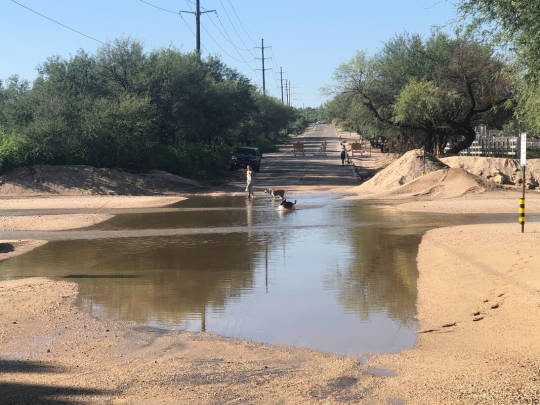
Amy's recovery is going rather well and after a couple of days, she has eschewed the walker and cane and is hobbling on her own. TP has started and while painful, her mobility is increasing every day. I took a short ride and checked out the wash that crosses Wentworth and Tanque Verde Loop roads. My ride was short, just to keep the muscles loose because....

....I wanted to join the Sabino Cycles shop ride on Saturday morning. Sixteen of us turned out for a surprising short distance of only 28 miles on too many crummy roads. I like the group but the route and lack of distance is alarming for a bike shop ride.

Returning to Amy's we had noticed a new restaurant opened a couple of miles from home called the "Barnyard Crafthouse & Eatery" so we checked it out for lunch. Good atmosphere and menu.
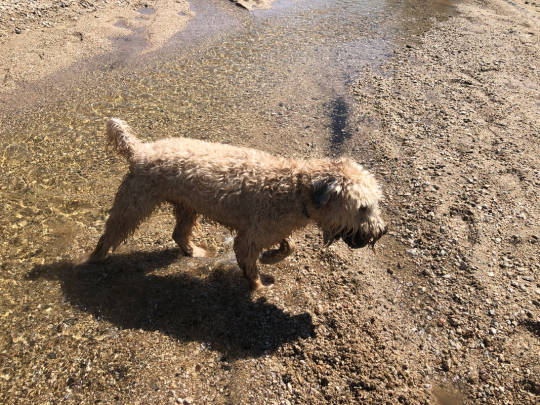
We also took Jack the Dog to a nearby wash where he ran into and out of the water, chasing a stick. Returning home, he was squirted with a hose. He loved both activities. Next day I got in a 45 mile ride and at the end of that day....
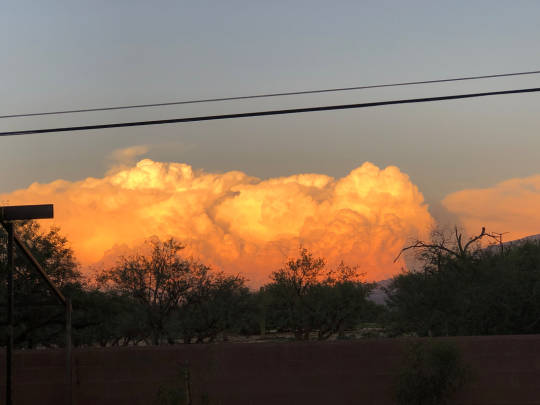
....noted the monsoon has shifted east, mostly in NM but it will return as we are now experiencing our 3rd wettest monsoon on record. Well, got a hike coming soon and need to check an alternate trail to get the group to our destination so may do that in a couple of days.
Mostly Riding published first on https://throttlebuffsite.tumblr.com/
0 notes
Photo

I can't take full credit for this photo, I gotta random cool dude Dominick half credit. I had pulled over right after the Tanque Verde bridge to take photos of the bats coming out. The sun was right in my eye but I thought I could hear someone calling to me. I put my hand up to block the sun and saw another guy on a bike on the other side of the wash calling to me and pointing. I made out "bobcat right there!". He saw my camera and thought I might be interested in photographing a bobcat. He was right, but over the next 5 minutes of him pointing and trying to call directions across the wash, I just couldn't see the darn thing. So, he finally got tired of trying to instruct me and rode over. When he got over, he was like "dude he's right there looking at you". Sure enough, he pointed and the guy was right below me, in the wash keeping a very close eye on me. There's a little more to the story, but this is too long as it is, so check back later today for another photo and the thrilling conclusion! 📷 Canon EOS 6D Mark II 🔭 EF100-400mm f/4.5-5.6L IS II USM 📋 271mm | 1/320s | f/5.6 | ISO-1600 📅 September 2019 🏜 Tucson, AZ https://bgboydphoto.com/photos/wildlife © 2019 BG Boyd Photography
0 notes
